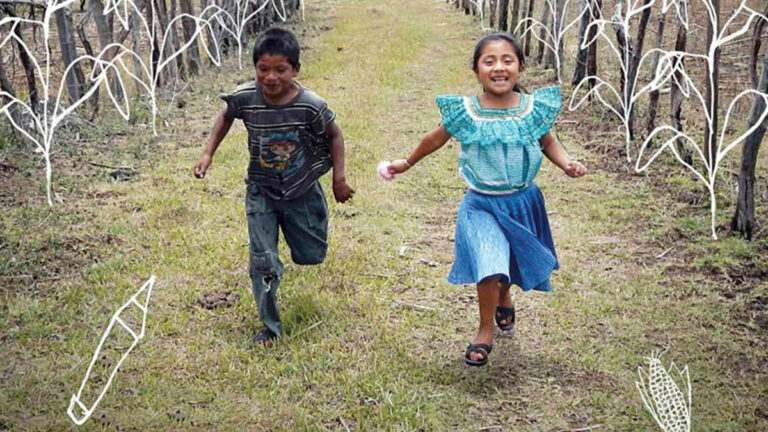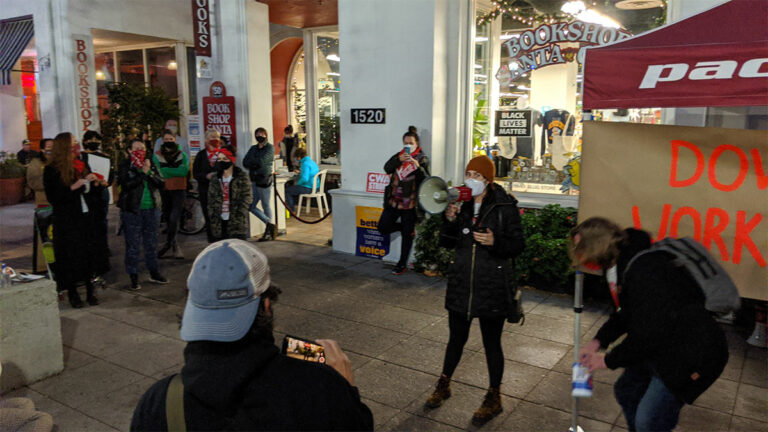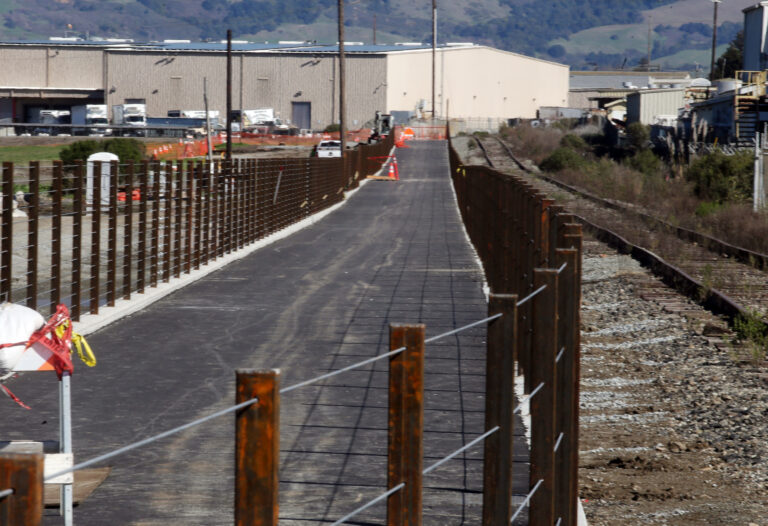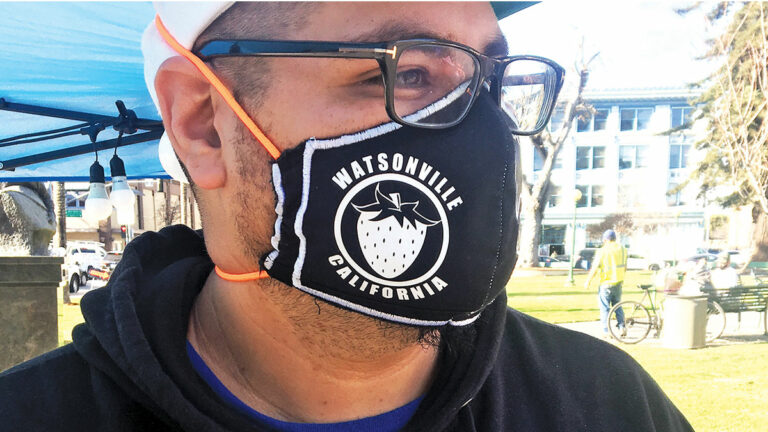Lea este artículo en español.
No one ever said that distributing a vaccine to tens of millions of Californians spread out across 58 counties in the middle of a pandemic would be easy.
But Gov. Gavin Newsom came pretty close last October.
At a press conference on the 19th, the governor assured the public that California has “long been in the vaccination business.” That projection of confidence came just three days after the CEO of the pharmaceutical giant Pfizer announced the company would seek the regulatory greenlight for its new COVID-19 vaccine. California, the governor said, would be ready.
Roughly 19 million flu shots every year. The recent history of a mass Swine Flu inoculation program in 2009. An early partnership with the federal government to plan for the coming distribution campaign. A new “Logistics Taskforce” established within the governor’s Office of Emergency Services. The governor cited all this as evidence that “experience with vaccinations is well established here in the state of California.”
More than three months later, the state is still scrambling to deliver. And the mammoth logistical headache of inoculating a state desperate for a return to pre-pandemic normalcy has become a pressing political one for Newsom. According to the most recent federal data, California is still sitting on 40% of its allotted vaccine, putting it in the bottom third of all 50 states. The messaging also has been hard to decipher, with information from the governor’s office sometimes at odds with that being issued by the counties.
And Californians are not happy. A mere 22% approve of how Newsom and the state government are overseeing vaccine distribution — while 40% rate it poor or very poor — according to a statewide survey released Tuesday by the UC Berkeley Institute of Governmental Studies. Overall, the poll shows a catastrophic fall from grace compared to early in the pandemic, when Newsom ranked among the most popular governors nationwide.
With Newsom now facing an increasingly credible recall effort, the slow, sputtering vaccine rollout raises the question: Didn’t the state have a plan for this?
Originally yes, it did — although the governor’s Office of Emergency Service isn’t responding to questions about those early preparations. During that Oct. 19 press conference, Newsom said that a state logistics task force had been working on a vaccine distribution plan for months. Public health experts say the state’s initial approach was modeled on the tried-and-true approach it uses to distribute flu shots — a plan that placed the bulk of the administrative onus on county governments, with the state serving a standard-setting and advisory role.
In the past, giving local health officers that flexibility “has been very advantageous,” said Dr. John Swartzberg, an infectious disease specialist and professor emeritus at the University of California, Berkeley School of Public Health.
“Unfortunately, during a pandemic, that approach can make it very difficult to implement things. And I think the state has recognized that.”
So last week, Newsom announced Plan B: proposals that he promises will simplify and speed up the process of pumping out vaccines. What went wrong with the initial plan — and shouldn’t the administration have anticipated these hiccups?
Many public health experts say most of the factors that have slowed the state’s inoculation plan are outside the governor’s control: California’s size and complexity, a fragmented public health care system spread over 58 counties, unsteady federal leadership and the challenges of transporting, storing and administering current COVID-19 vaccines.
But some of the hurdles may be of the administration’s own making.
The state’s initial distribution framework, which prioritized Californians by occupation group, underlying medical conditions and housing status, may have slowed the process by creating a system that was difficult to administer and hard for the public to understand.
And some critics bemoan what they see as the governor’s penchant for making vague, premature announcements prior to consulting those most affected.
Jeff Smith, executive officer for Santa Clara County, is one of those critics.
“For the past year, the entire approach that the governor has taken to the pandemic has been disorganized and petulant,” said Smith, who disagrees that county governments are sitting on unused vaccine. “Whenever he feels like he’s getting bad press, he does something. And the things that he does are not wise things and they’re not driven by scientific decisions,” said Smith.
A vaccine rollout that is unprecendented
No matter how much blame Newsom deserves, Democratic consultant Garry South said the governor is sure to get the lion’s share.
“I’ve seen this movie before,” said South, former campaign manager to Gray Davis, the only governor in California history to be successfully recalled. Davis, South noted, was booted from office in large part for his handling of the state’s electricity crisis in 2001. ”The governor gets blamed not for the problem, but for not solving the problem.”
California is not the only state struggling. Vaccine production has been slower than many experts expected. Public health authorities say the outgoing Trump administration offered neither the guidance nor the necessary funding to states. The Pfizer vaccine must be stored at -94 degrees Fahrenheit, while the Moderna version can be kept at a balmy -4 F. Once thawed, both have a short shelf life.
“I would be hesitant to make any really strong judgments right now as to where things have gone wrong,” said Democratic state Sen. Josh Newman from Fullerton, one of roughly a dozen state Democratic legislators who get weekly Zoom briefings on COVID from the governor’s office. “It’s unprecedented (and) it’s inherently complicated.”
The complexity of the current vaccine campaign is ”a quantum leap” ahead of all of our other vaccination programs, said Swartzberg. “No one that I know expected it to go smoothly. And, you know, right now it looks like it’s gone just horrifically. But I think we’re really being granular, when — day by day — we critique it.”
It’s no coincidence that the states that seem to have had the most success in pushing out vaccines — West Virginia, the Dakotas — have populations a mere fraction of Los Angeles County’s and without nearly the linguistic and cultural diversity, said Jeff Goad, chair of the Department of Pharmacy Practice at Chapman University. He sits on the state’s Drafting Guidelines Workgroup, a panel of experts that help determine which groups should receive vaccines first.
“We’re in a class by ourselves,” he said.
In explaining the slow rollout last week, the governor likened changing policy to “shifting course” on a “large ship.” But given how fragmented the state’s healthcare system is, with vaccine distribution responsibilities split up among 58 county governments, nine multi-county hospital networks and at least half a dozen pharmacy chains, “it’s more like a flotilla,” said Anthony Wright, director of Health Access and a member of the state’s vaccine advisory committee.
The state’s early planning efforts were also the victim of bad timing, said Tony Iton, a senior vice president of the California Endowment. Vaccine deployment planning took place just as the state’s COVID caseloads were peaking once again and hospitals in Southern California were turning away ambulances.
“The very people you need to sit back and do the analysis and research and the planning are caught up managing the day to day issues related to the just incredible surge we saw over the winter,” he said. “I know the folks that are working up there (in Sacramento) are — they’re burnt. They’ve just been running full speed for a year, and humans can’t take that.”
The governor’s early optimism notwithstanding, none of these hurdles were lost on those inside the Newsom administration this winter.
Six months = 300,000 shots a day
In a mid-December podcast produced by the Office of Emergency Services, Grady Joseph, assistant director for the state’s Covid-19 Logistics Task Force, predicted that the vaccination campaign would make the state’s earlier organizational struggles to buy and distribute personal protective equipment and ramp up testing “look fairly trivial.”
“If you want to vaccinate everybody within a six month time period, assuming you have the supplies and the vaccine, we have to do an excess of 300,000 vaccines a day,” said Grady. “If you compare that to the amount of COVID testing we’ve done, some of the highest days we’ve ever had have been 215,000.”
On Monday, the state administered a little over 167,000 doses, according to data collected by the Los Angeles Times.
The overhaul of the state vaccine plan announced over the last two weeks are intended to speed up the process.
On Jan. 22, the state launched a website where anyone in the state can sign up to be notified when they are eligible for a vaccine. Up until then, confused and anxious Californians seeking information would often ping pong between their county, providers and insurers.
The governor also announced that the state would hire Blue Shield to coordinate where vaccines will go and to gather data on distribution.
And last week, the governor announced a simplified eligibility system. Once counties finish vaccinating healthcare workers, next in line will be teachers, childcare workers, agricultural workers and emergency responders, and Californians over the age of 65. After that, counties will move through their populations solely by age.
But demonstrating just how politically fraught vaccine distribution is, both the new eligibility plan and the Blue Shield announcement have earned the governor ire from fresh quarters.
The cost of simplifying the eligibility framework is that many high-risk candidates like big box store clerks and younger people with chronic health issues or disabilities have been pushed to the back of the line.
José Padilla is director of the nonprofit California Rural Legal Assistance and sits on the state’s community vaccine advisory committee. He said he was taken aback when, two weeks ago, State Epidemiologist Erica Pan and Surgeon General Nadine Burke Harris floated the idea of the new approach.
“Changing the eligibility criteria that is going to impact the rollout six meetings into the process just didn’t feel fair to me,” he said.
On Friday, the directors of lobbying groups that represent the state’s counties and county health executives wrote a joint letter to the governor warning that the Blue Shield proposal, “for which there is little detail, threatens to eclipse our members’ core local public health expertise and functions.”
“There have been so many fits and starts and changing directions of the vaccine rollout that it’s really tied the hands of counties,” said Graham Knaus, executive director for the California State Association of Counties. We “have gotten in our own way, in terms of the instability of what the game plan is.”
Vaccination: Newsom ‘shooting for the moon’ yet again?
Smith, the executive of Santa Clara County, argued that the state’s decision to bring in a company to ensure that doses are accurately being administered a “solution looking for a problem” and based on inaccurate data. In an email exchange he shared, an employee with the California Department of Public Health inquired about 24,159 doses that were “unaccounted for.” Smith said the real number is zero.
“The main problem right now is the amount of vaccine that’s available, not the utilization or distribution,” he said. “This one-size-fits-all (approach) hiring an insurance company is really just a political effort to try to take the heat off of the governor for not having a confident approach to the pandemic.” Smith noted that the county was only informed of the Blue Shield decision an hour before it was made public.
To critics, the Blue Shield announcement is part of a pattern of unclear and premature communication from the administration.
In mid-January, for example, the governor announced that all Californians over 65 were now eligible for the vaccine. But that was a state recommendation, a subtlety lost on many Californians who set about scrambling for their dose. Some counties expressed frustration, noting that limits on vaccine supply would make it impossible to vaccinate all residents over that age anytime soon.
“If there’s an expectation in a community that they’re now eligible and can hop into a provider or make an appointment and get it, but we can’t deliver that, that’s a very difficult place to be,” said Knaus at the California State Association of Counties.
For Newsom, California’s vaccine delay poses a quandary. He has long made big ambitious goal-setting a hallmark of his political style. When running for governor in 2018, he promised to introduce a state-funded single-payer health care system, despite a prohibitively high price tag and no obvious political pathway in the Legislature. He also vowed to oversee the construction of 3.5 million new homes — which would require the state to break its annual construction record by 36% every year for eight years.
That shoot-for-the-moon approach may serve the governor well on the campaign trail, said Dan Schnur, a professor at USC’s Annenberg School of Communications who has worked the press operations for Republican politicians such as former Gov. Pete Wilson and the late Arizona U.S. Sen. John McCain.
On most issues, making big, inspiring promises and then failing to fully deliver “hasn’t caused him any problems because most voters aren’t paying close attention to the day-to-day machinations of government,” said Schnur.
“But when it comes to COVID, they are paying close attention.”
Note: This story was revised to reflect that big box store workers, but not grocery clerks, have fallen to the back of the state’s priority list for COVID vaccination.
CalMatters.org is a nonprofit, nonpartisan media venture explaining California policies and politics.

























